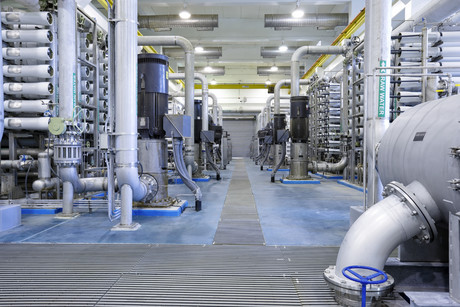Desalination to the rescue

The world has very little fresh water and it is running out. At tens of billions of tonnes yearly, the fresh water of the ice caps is falling into the salty sea, which is already 97% of the world’s water.
Rising sea levels will cause mayhem with the supplies of most of the world’s cities because they sit low down near the sea. Much of India’s water table drops around 0.3 m a year. Why? Growing population. The barren farms of Syria show what happens when you extract all the ground water. Recycling of water is practised only by a tiny percentage of the world’s countries.
All this means that desalination gets more competitive even if its cost stays still: the competition such as cleaning river water or lakes or sucking up dying aquifers is either disappearing or getting more expensive. Desalination can work on salt lakes: the Caspian Sea has 70% of global inland salt water, yet it is almost surrounded by water-stressed regions. Actually, inland brackish water is 100 times as abundant as salt lakes and desalination can tackle it using much less energy than is needed for sea water.
So what’s not to like? Well, in the past desalination has been so expensive that it has been the last resort, with Dubai, Saudi Arabia, Israel and Kuwait getting all or most of their water that way because they have no alternative. Desalination plants have got bigger and bigger, with costs rising past the $1 billion level, and they have often damaged oceanic wildlife by sucking in fish eggs and spewing out concentrated brine in a poorly controlled way that kills wildlife.
In most countries, the most competitive desalination technology remains reverse osmosis using electric pumps. Desalination plants have almost always satisfied their huge appetite for electricity through fossil fuel plants on-site or behind their grid connection, warming the globe with carbon dioxide — with some emitting localised poisonous gases as well.
The good news is that all this is being tackled very successfully. Saudi Arabia has the world’s largest operating desalination plant and it burns a lot of gas, as does the 140 MW one in Israel. However, Saudi Arabia is going entirely solar. The cooler country, China, is starting to need a lot of desalination and so it is deploying a lot of wind + solar and solar alone desalination plants with zero emission. In fact, as with grid supply, the zero emission options are rapidly becoming lower cost than burning fossil fuels. Yes, there are other options such as biosaline agriculture giving kelp to samphire and quinoa, but all are needed because we have to drink too.
Desalination is practised in about 150 countries, with many more joining the fray. Demand is now so varied that plants of all sizes are now needed and in numbers and later volume of water, the medium and small ones may show greatest growth in future despite several monsters being planned. Economy of scale can be more than a matter of making ever larger plants. Indeed, these are already into diminishing returns. Economy of scale can also mean mass production of standard medium- and small-sized plants, and that work has scarcely begun.
With cyber attacks and weather shutting down grids and their electricity prices typically rising, the dropping costs of off-grid zero emission electricity are increasingly preferred, with the user enjoying both predictability and rapid adjustment.
It is time for a report on the heart of future desalination. This is the new IDTechEx report — ‘Desalination: Off Grid Zero Emission 2018-2028’. It predicts that, coming from very little in 2018, off-grid zero emission desalination will be a rapidly growing $35 billion market in 2028.
The report looks closely at a roadmap of exciting new desalination and electricity technologies that will boost performance and reduce cost, in particular reducing what is usually the largest cost element — electricity. It embraces photovoltaics technology that is three times more efficient; aerial wind energy (AWE) such as tethered kites that are more affordable and versatile than ground wind turbines; and many new forms of water power that viably downsize and are sufficiently rugged and free of marine growth. It also looks closely at combinations of harvesting technologies for security of supply and minimising storage.
The 160-page report covering 79 organisations is replete with new infograms and forecasts. They clarify such things as the increasing interaction and integration in this emerging industry. Desalination plants will refill the Dead Sea while providing drinking water and many will provide spare electricity for communities. Some will be part of village, island and ship microgrids. The report will cover all future desalination options and why certain ones are dying out.
The increasingly popular mobile desalinators will sometimes double as transport; provide electricity for farm robots, not just water; and replace increasingly unaffordable diesel gensets expensively modified to meet new emissions laws and involving yesterday’s crippling fuel supply systems. There are many strategies for avoiding those expensive, dangerous, short-lived batteries in desalination, and actual examples are given.
Multilingual PhD level analysts from IDTechEx have carried out interviews worldwide, mined restricted databases and thought creatively on your behalf, presenting many new ideas. The research was carried out in 2017–18 and is constantly updated. There are even drilldown reports for those wanting more, covering AWE, an off-grid overview, electricity from urban infrastructure and much more.
For more information, visit www.IDTechEx.com/desalination.
Originally published here.
New membranes could help eliminate brine waste at desalination plants
Membranes packed with charge can help overcome the current salinity limit, making it easier to...
Balancing energy and water in data centres
World Water Day served as a timely reminder that we all have a role to play in tackling climate...
Greater Western Water uses Gorman-Rupp pump in water delivery project
The Gorman-Rupp pump was selected for Greater Western Water's WIN project to deliver...










